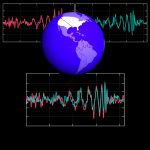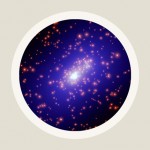Gravitational waves / Elementary tour part 3: Gravitational wave astronomy
Every single atom can radiate and absorb electromagnetic waves. The light reaching us from astronomical sources is a hodgepodge of little snippets of radiation, each snippet produced by one of the object’s myriads of atoms. That’s good news and bad news. The good news is that we can trace radiation snippets back to where they came from, and thus reconstruct a detailed picture of the object’s structure. The bad news: electromagnetic radiation is as easily absorbed as it is produced. If there’s enough matter between us and an astronomical object, it will absorb and scatter light so badly that we might see a very blurry picture, or no picture at all. Electromagnetic information is, in that sense, superficial. We cannot see the interior of the sun or a supernova, merely its outer layers.
Gravitational waves are different. First of all, what they convey is less a picture than a sound, not so much a collection of lots of different contributions, but a harmonic composite wave. In that way, they are similar to a sound waveform that reaches us from an instrument: such a waveform is a harmonic whole, while light would show us all kinds of details about different regions of the instruments (“how the instrument looks”). Just as a sound wave contains information about how the instrument vibrates, the gravitational waves carry information about the events at which they were formed. Most importantly: Almost all astronomical bodies are transparent to gravitational waves. The waves thus carry information that we could not obtain by other means – information about the flow of matter in the heart of a supernova, or about the material properties of merging neutron stars. They promise data about regions that would otherwise be hidden, or accessible only indirectly through computer simulations. One such simulation is shown below: the density distribution in the center of a supernova, one second after the beginning of the explosion. Brighter regions correspond to higher density:
![[© L. Scheck, Max-Planck-Institute for Astrophysics]](https://www.einstein-online.info/wp-content/uploads/density_example.jpg)
[© L. Scheck, Max-Planck-Institute for Astrophysics]
However, even gravitational waves produced in the most violent commotions in our cosmic neighbourhood are very weak indeed, once they’ve reached earth. True, a supernova explosion in a nearby galaxy will produce, within the first few seconds, the energy of a trillion sextillion nuclear explosions, with much of that energy radiated away in the form of gravitational waves – but on its way to earth, all that energy dilutes to a pitiful remnant wave, changing the distance between the earth and the sun by the diameter of a hydrogen atom, at best. This makes the detection of gravitational waves a supremely difficult technical endeavor.








